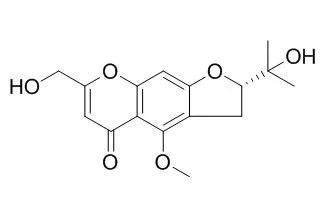| Description: |
Cimifugin evidently inhibits FITC-induced type 2 allergic contact dermatitis,and its mechanism might related to regulating the balance of Th1 /Th2 by inhibiting type 2 cytokines. Cimifugin displayed low to moderate inhibition towards AChE and BChE (3.12 and 21.63%, respectively) at 200 ug/mL. |
| Targets: |
IFN-γ | IL Receptor | AChR | BChR |
| In vitro: |
| J Cell Mol Med . 2017 Nov;21(11):2926-2936. | | Cimifugin suppresses allergic inflammation by reducing epithelial derived initiative key factors via regulating tight junctions[Pubmed: 28597545] | | Abstract
Cimifugin is a bioactive component of Saposhnikovia divaricata, a Chinese herb for treating allergy. Our previous studies demonstrated that Cimifugin inhibited allergic inflammation efficiently. This study aims to determine the mechanism of Cimifugin on epithelial cells in allergic inflammation. Mice were sensitized and challenged with FITC to establish type 2 atopic dermatitis (AD) model. The initial stage of AD model, in which mice were just sensitized with FITC, was established in vivo and immortalized human epidermal (HaCaT) cells were utilized in vitro. Initiative key cytokines, TSLP and IL-33, were measured by ELISA, the junctions in ECs were observed by electron microscopy and TJs (CLDN-1, occludin and CLDND1) were assessed by Western blot, immunohistochemistry and immunofluorescence. The results showed that TSLP and IL-33 were inhibited significantly by Cimifugin in the initial stage of AD model. Simultaneously, Cimifugin reduced the separated gap among the epithelial cells and increased the expression of TJs. Similar effects on TSLP/IL-33 and TJs were obtained in vitro. The effect of Cimifugin on TSLP decreased significantly when expression of CLDN1 was interfered with siRNA and this implied Cimifugin inhibits initiative cytokines through restoring TJs. Furthermore, Cimifugin administered only in the initial stage obviously attenuated the ultimate allergic inflammation, which indicate that impacts of Cimifugin in the initial stage on TSLP/IL-33 and TJs are sufficient for suppressing allergic inflammation. This study not only revealed the mechanisms of Cimifugin, but also indicated the possibility of initiative key cytokines and TJs as therapeutic targets.
Keywords: TSLP; IL-33; atopic dermatitis; Cimifugin; tight junctions. |
|
| In vivo: |
| Pharmacol. Clin. Chinese Mat. Med., 2014, 30(2):28-30. | | Cimifugin inhibits allergic contact dermatitis by regulating type 2 cytokines.[Reference: WebLink] | This study was carried out to investigate the effective and mechanism of Cimifugin on type 2 allergic contact dermatitis induced by FITC.
METHODS AND RESULTS:
The BALB /c mice were sensitized with FITC on days 1 and 2,on the shaved abdomen skin. On day 6,the animals were challenged on their right ears with FITC. Simultaneously,the mice were administered Cimifugin from day 1 to day 5. On day 7,ear swelling was measured and the infiltration of lymphocytic was investigated by hematoxylin and eosin( HE) staining. The levels of IL-4,IL-9,IL-13 and IFN-γ were quantified by ELISA and BCA. The results suggested that mouse ear swelling was dramatically inhibited by25 mg /kg,50 mg /kg Cimifugin. Histopathological results indicated that mice given Cimifugin has significant improvement on local tissue fluid exudation,congestion,and lymphocytic infiltration was remarkably reduced by Cimifugin. At the same time type 2 cytokines IL-4,IL-9,IL-13in the mouse ear tissue homogenate were obviously reduced by Cimifugin,while no significant changes with type 1 cytokines IFN-γ.
CONCLUSIONS:
Cimifugin evidently inhibited FITC-induced type 2 allergic contact dermatitis,and its mechanism might related to regulating the balance of Th1 /Th2 by inhibiting type 2 cytokines. |
|






 Cell. 2018 Jan 11;172(1-2):249-261.e12. doi: 10.1016/j.cell.2017.12.019.IF=36.216(2019)
Cell. 2018 Jan 11;172(1-2):249-261.e12. doi: 10.1016/j.cell.2017.12.019.IF=36.216(2019) Cell Metab. 2020 Mar 3;31(3):534-548.e5. doi: 10.1016/j.cmet.2020.01.002.IF=22.415(2019)
Cell Metab. 2020 Mar 3;31(3):534-548.e5. doi: 10.1016/j.cmet.2020.01.002.IF=22.415(2019) Mol Cell. 2017 Nov 16;68(4):673-685.e6. doi: 10.1016/j.molcel.2017.10.022.IF=14.548(2019)
Mol Cell. 2017 Nov 16;68(4):673-685.e6. doi: 10.1016/j.molcel.2017.10.022.IF=14.548(2019)